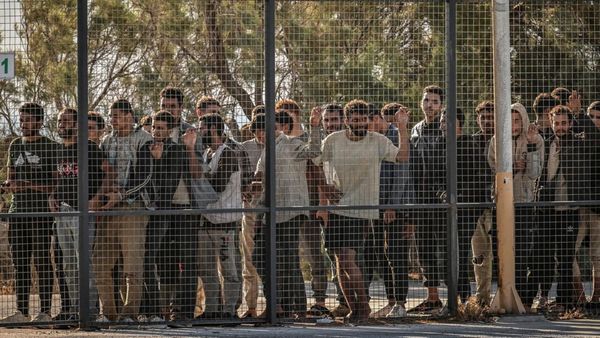
Queen Elizabeth II reigned for more than 70 years and for 30 years during that time a vicious conflict was fought in the part of her United Kingdom known as Northern Ireland.
About 3,600 people were killed and more than 30,000 wounded from 1969 until the signing of an agreement in 1998, which largely brought peace between those fighting against British rule in the northern province of Ireland, and those battling to preserve and defend the union with Britain.
The fighting, euphemistically known as “the Troubles”, was brutal, bitter, and sectarian.
British troops, the Northern Irish security services, Irish Republican Army (IRA) fighters, and pro-British Loyalist armed groups bombed and shot, killed and maimed, as they turned city streets and rural towns into guerrilla-war battlefields.
For generations of Irish nationalists and republicans, the British Crown and its forces were an enemy responsible for the degradation of centuries of colonial rule in Ireland.
Yet, on Thursday, two Irish soldiers lowered Ireland’s tricolour flag to half-staff at a government building in Dublin to mark the queen’s death. Irish embassies around the world also followed suit and lowered the republic’s flag as a mark of respect.
The Irish flag has been lowered to half mast at Government Buildings this evening to mark the death of HM Queen Elizabeth.
Statement from Taoiseach @MichealMartinTD ➡️ https://t.co/luw9aLl0sl pic.twitter.com/kvs7Ki9zwv
— MerrionStreet.ie (@merrionstreet) September 8, 2022
The flag at the Embassy has been lowered to half staff to mark the death of Her Majesty Queen Elizabeth II. pic.twitter.com/HDm959iFSL
— Embassy of Ireland Cairo (@IRLEmbCairo) September 9, 2022
Ireland’s President Michael D Higgins issued a statement “on behalf of the people of Ireland” expressing heartfelt sympathy.
Former Sinn Fein leader Gerry Adams – who had headed the party once commonly referred to as the political wing of the IRA – retweeted a message of condolence from the republican party’s current leader.
“To the Royal Family and all who mourn the death of Queen Elizabeth, especially Irish Unionists, I extend sincere sympathy,” Sinn Fein leader Mary Lou McDonald wrote in a tweet.
“She lived a long, full life. In her lifetime relationships between our countries were changed and changing. I salute her contribution to this transformation.”
To the Royal Family and all who mourn the death of Queen Elizabeth, especially Irish Unionists, I extend sincere sympathy. She lived a long, full life. In her lifetime relationships between our countries were changed and changing. I salute her contribution to this transformation
— Mary Lou McDonald (@MaryLouMcDonald) September 8, 2022
The expression of sympathy in Ireland from all quarters demonstrates how Queen Elizabeth achieved something remarkable in the fraught history of the two countries.
And it began with a visit.
Symbols and reconciliation
In 2011, Elizabeth became the first British monarch to visit the Republic of Ireland since the country fought and gained independence from London almost a century earlier.
During her four-day trip, the queen wore green – the symbolism not lost in a country referred to as the “emerald isle”.
She laid a wreath at a monument dedicated to those who had fought and died for Irish independence from Britain.
She stepped onto the pitch at Dublin’s Croke Park stadium, the home of traditional Irish sport and the scene of a mass killing of 14 people by British forces almost 100 years earlier.
Then at a dinner in Dublin Castle, the former nerve centre of British rule in Ireland, the queen spoke some words in the Irish language.
The queen’s use of Gaelic, once banned under British rule, to begin her speech drew an audible gasp of surprise and a spontaneous round of applause from guests in attendance.
Min @EamonRyan described as "pivotal" the moment Queen Elizabeth spoke Irish at the State dinner in Dublin Castle in 2011 pic.twitter.com/zQa0T6yWbK
— Morning Ireland (@morningireland) September 9, 2022
The queen’s visit – during which she expressed regret for centuries of conflict between the two countries – was a powerful gesture of reconciliation for Britain’s bloody past in Ireland.
Her description of the two countries as “firm friends and equal partners”, and her many other gestures, had the power to reset relations with Britain for more than one generation in Ireland.
“During those memorable few days eleven years ago, the queen did not shy away from the shadows of the past,” President Higgins wrote in his message of condolence.
“Her moving words and gestures of respect were deeply appreciated and admired by the people of Ireland.”
Healing history
A year after her visit to Ireland, the queen met and shook the hand of former IRA commander and then-Deputy First Minister of Northern Ireland, the late Martin McGuinness, in Belfast.
That handshake was historic.
The IRA had killed the queen’s cousin Lord Louis Mountbatten – the last viceroy of India – in 1979 when they blew up his fishing boat in Donegal Bay, in the republic’s northwest. Three other relatives of Mountbatten died in the attack.

Thirty years of bloodshed between Irish nationalists, pro-British loyalists, and the British military in British-run Northern Ireland was largely ended by the 1998 peace deal that was brokered by Irish and British leaders.
But it was the queen’s visit 13 years after the signing of the peace agreement that provided a degree of personal, historic healing.
Writing in Britain’s Guardian newspaper shortly after the Queen’s visit, Irish columnist Fintan O’Toole summed up a feeling likely experienced by many Irish people.
“There are, presumably, two rules the Queen has absorbed so deeply that they have become instinctive: don’t take risks; don’t stir emotions,” O’Toole wrote.
“She broke both rules in Ireland last week,” he wrote.
“To the great surprise of those of us who have little time for monarchy, she walked that line with amazing grace. It is not simply that she didn’t put a foot wrong. It is that every step seemed exactly right.”







